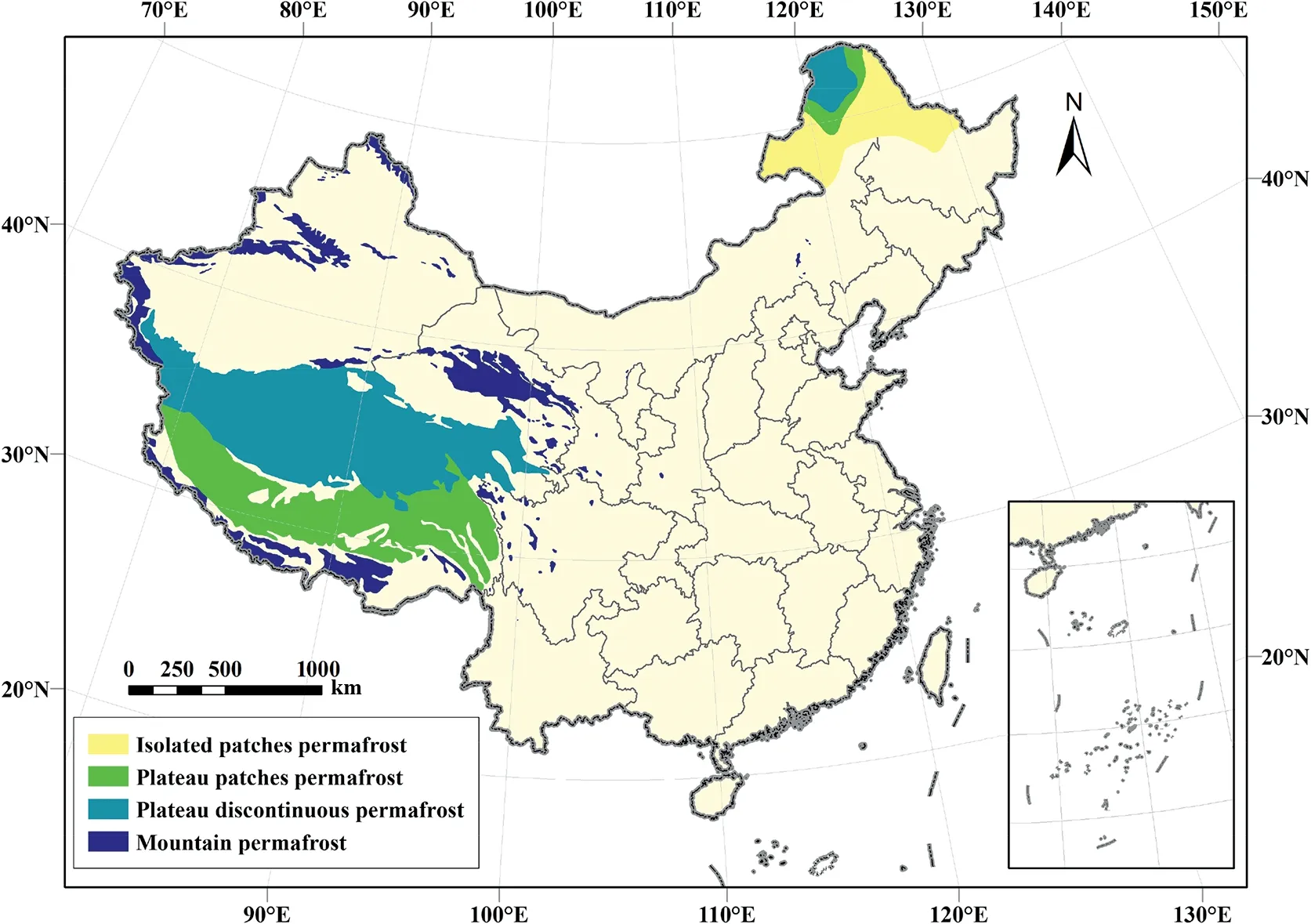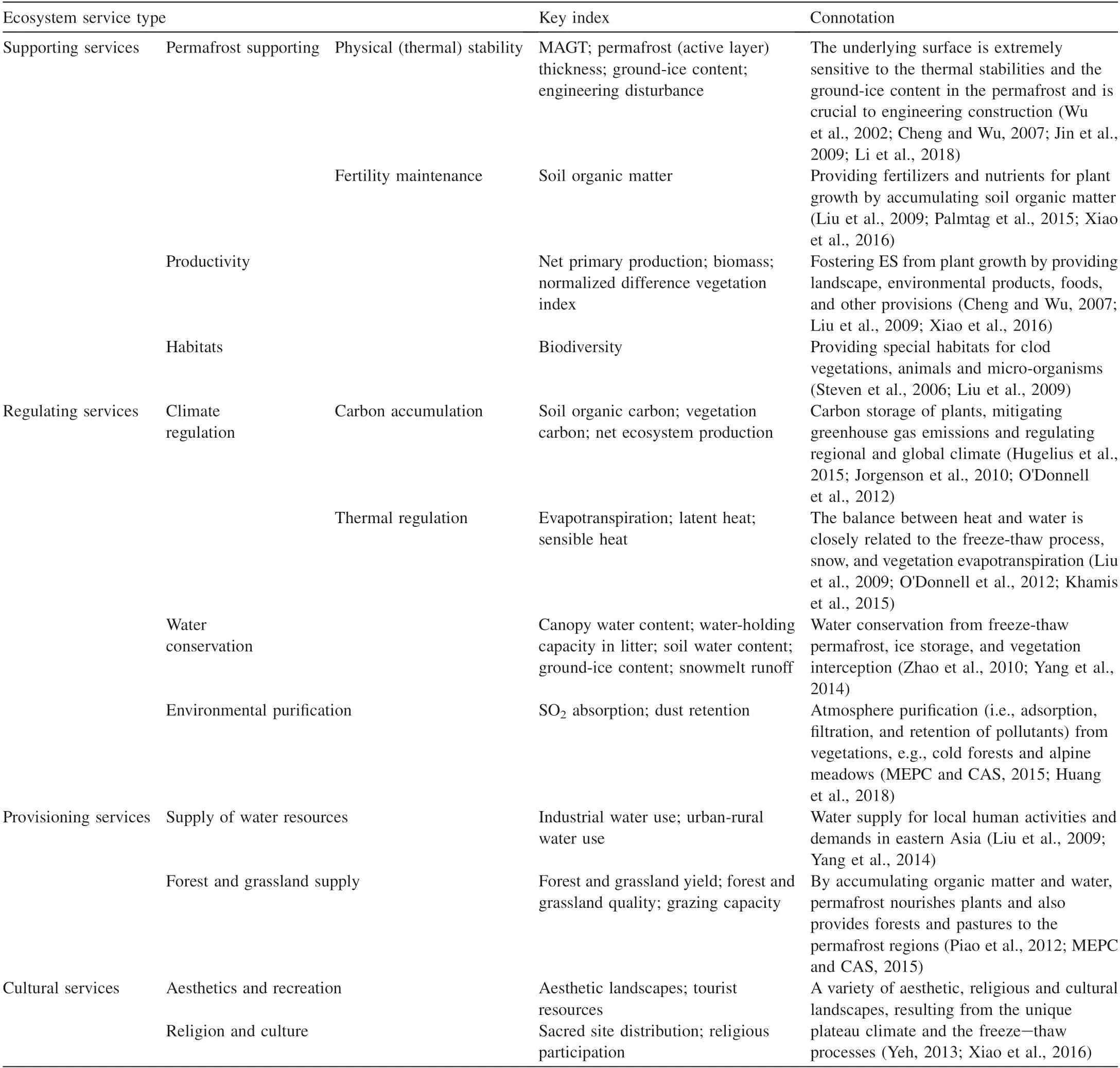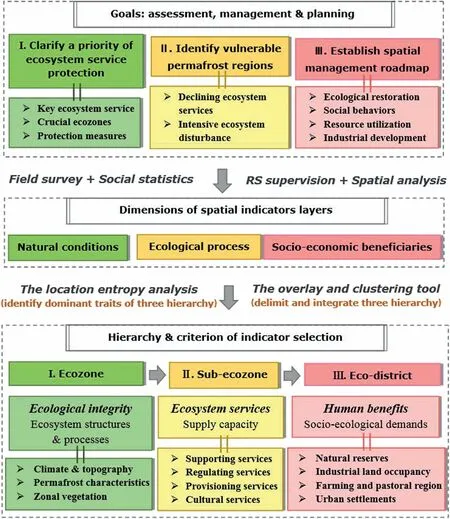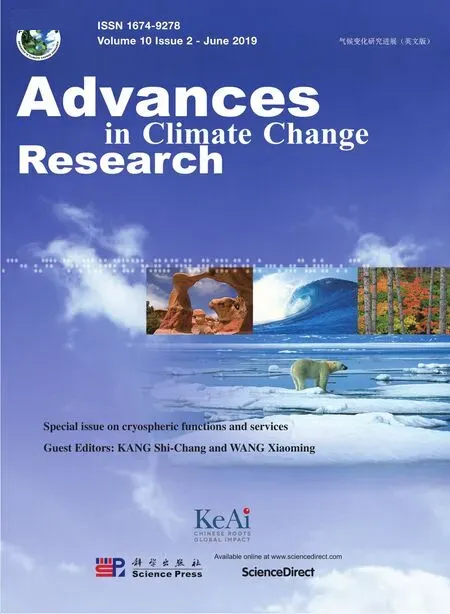An ecosystem services zoning framework for the permafrost regions of China
2019-08-13XULinXinYANGDeWeiWUTonHuaYIShuHuaFANGYiPenXIAOCunDeLINHaoXiHUANGJinChuanClaudienHABIMANASIMBI
XU Lin-Xin, YANG De-Wei*, WU Ton-Hua, YI Shu-Hua,d,e, FANG Yi-Pen,XIAO Cun-De, LIN Hao-Xi, HUANG Jin-Chuan, Claudien HABIMANA SIMBI
a Key Laboratory of Urban Environment and Health, Institute of Urban Environment, Chinese Academy of Sciences, Xiamen, 361021, China
b College of Resources and Environment, University of Chinese Academy of Sciences, Beijing, 100049, China
c State Key Laboratory of Cryospheric Science, Northwest Institute of Eco-Environment and Resources, Chinese Academy of Sciences, Lanzhou, 730000, China
d Institute of Fragile Ecosystem and Environment, Nantong University, Nantong, 226007, China
e School of Geographic Sciences, Nantong University, Nantong, 226007, China
f Institute of Mountain Hazards & Environment, Chinese Academy of Sciences, Chengdu, 610041, China
g State Key Laboratory of Earth Surface Processes and Resource Ecology, Beijing Normal University, Beijing, 100875, China h Key Laboratory of Regional Sustainable Development Modeling, Chinese Academy of Sciences, Beijing, 100101, China
i Institute of Geographic Sciences and Natural Resources Research, Chinese Academy of Sciences, Beijing, 100101, China
Abstract The degradation of the permafrost regions, resulting from intensive anthropogenic activities and global warming, has led to the loss of ecosystem services and is threating human well-being.Nevertheless,the real ecosystem service values and their complete zoning system in the permafrost regions have received insufficient attention. Research gaps between the identification of permafrost-based ecosystem services and ecosystem management are seriously constraining the development of cryospheric science. Thus, an ecosystem service zoning framework that links ecosystem services with human welfares is proposed to solve the abovementioned challenges in the permafrost regions of China.The threetiered zoning framework for ecosystem services,consisting of zoning goals,principles,hierarchy,methodology,and nomenclature,is proposed for the permafrost regions of China. A combined method, i.e., GIS spatial tools, the location entropy analysis model, and ecosystem services assessment, was employed to distinguish ecosystem conditions, ecosystem service supply, and beneficiaries into these three-grade ecosystem service zones. Hierarchical and dynamic zoning could clarify protection priorities of ecosystems and ecosystem services in terms of regions,grades, and types. The framework could contribute to sustainable management of ecosystem services in the cryosphere.
Keywords: Demand; Ecosystem services; Ecological zoning; Permafrost; Supply
1. Introduction
Permafrost, defined as frozen soil that remains below 0°C for at least two consecutive years, is a special product of the heat exchange between land and atmosphere in the cryosphere(Soons, 1981; Zhou et al., 2000). Permafrost covers 22% of the global land surface, with significant effects on its surrounding areas (Zhang et al., 1999). On the one hand,permafrost, as a crucial carrier of ecological security and industrial development in the cryosphere, plays a unique role in regional vegetation, hydrology, climate, land use, and engineering construction due to its hydro-thermal properties. On the other hand, permafrost is recognized as one of the most vulnerable zones in the world and is extremely sensitive to global climate change and human disturbance (Wu et al.,2002; Cheng and Wu, 2007; Schuur et al., 2008; Jorgenson et al., 2010). More specifically, due to the exacerbation of global warming and intensive anthropogenic activities, most permafrost regions have experienced prominent degradation in recent decades,e.g.,permafrost shrinking,ground temperature increases, active layer deepening, ground-ice melting, thaw collapses, and subsidence (Jorgenson et al., 2001; Cheng and Wu, 2007; Li et al., 2018). Numerous studies have indicated that these degradations challenge permafrost stability and the underlying ecosystems, which, in turn, damages the ecosystem services (ES) upon which humans depend (Wang et al., 2006; Jorgenson et al., 2013; Chen et al., 2018). In permafrost regions, declining ES have caused severe ecological and economical losses, e.g., damage to railway engineering and the shrinkage of grasslands (Wu et al., 2002; Ma et al., 2009; Chen et al., 2014). Therefore, the quantification and clarification of the changes and potential influences of ecosystem functions and services is indispensable to establishing a zoning framework and implementing effective management in permafrost regions. This will contribute to a rapid response to the degradation of ecosystem functions and services and maintain a healthy ecosystem evolution in the cryosphere.
Ecological zoning in the permafrost regions originates from the identification of permafrost characteristics, including ground temperature, active layer thickness, ground-ice content, and the mapping of permafrost distributions and variations (Anisimov and Nelson, 1997; Zhang et al., 1999; Wu et al., 2018). Unfortunately, little is known about mapping and zoning of permafrost changes and any associated ecoeconomic effects, such as zoning and engineering selection resulting from the assessment of thermal stability and thawing sensitivity in the permafrost (Jin et al., 2009; Li et al., 2018),and the mapping of typical ES associated with soil carbon accumulation, water conservation, and vegetation cover(Cheng and Wu,2007; Jorgenson et al., 2013; Hugelius et al.,2015). Generally, current ecological zoning has shifted from ecological features to ES in permafrost regions. However,theoretical and methodological gaps still remain in current research. First, ES types in permafrost regions have rarely been mentioned in previous ES assessment frameworks, with limited information about the diversity,distribution and spatial differentiation of ES, and their relations with regional socioeconomic characteristics (Costanza et al., 1997; Xiao et al.,2016). Second, in cryospheric regions, most ecological zoning cases attach importance to ecological functions and their distribution, with fewer concerns about ES and their supply-demand relationships(Anisimov and Nelson,1997;Jin et al., 2009; MEPC and CAS, 2015). Lastly, the spatial differentiation of ES in zoning frameworks should be highlighted for the spatial diversity of permafrost types, ranges, and complexity (Anisimov and Nelson, 1997; Luo et al., 2016).
Recently, research has increasingly shifted focus to value changes, mapping, zoning, trade-offs, and sustainability management of ES in various ecosystems. Nevertheless, the evaluation and regulation of ES in the permafrost and the cryosphere have not been completely addressed in current global evaluation systems. Research gaps in ES assessment and zoning in permafrost regions are seriously constraining the understanding and development of cryospheric science (Qin,2017). China's permafrost regions, consisting of highlatitudinal permafrost in northern China and high-altitudinal permafrost in the Qinghai-Tibetan Plateau, are some of the most significant and sensitive regions in the global cryosphere.However, there is no complete or special zoning of ES in China's permafrost regions. Therefore, there is an urgent need to establish an ES zoning framework that links socioecological elements in the permafrost regions in China.
In this study,based on reviews of the latest research and an analysis of permafrost conditions, an ES zoning framework that consists of zoning goals,principles,methodologies,types,and nomenclature is proposed for China's permafrost regions.In addition, we discuss the zoning hierarchy and dynamics of ES for permafrost areas. This study contributes to the understanding of the relationship between the supply and demand of ES, thus achieving effective management of ES in China's permafrost regions.
2. Study area
2.1. Permafrost distribution
Permafrost covers approximately 2.15×106km2or 22.3%of China's land area, including latitudinal and altitudinal permafrost, as shown in Fig. 1 (Zhou and Guo, 1981; Zhou et al., 2000). High-latitudinal permafrost is mainly distributed in northeastern China, with a terrestrial area of 0.38 × 106km2and a mean annual ground temperature(MAGT) range from -2.0 to 0°C (Cheng, 1984; Jin et al.,2000; Ran et al., 2012). In China, high-altitudinal permafrost can be divided into mountain and plateau permafrost.Approximately 0.71 × 106km2of mountain permafrost is distributed in the alpines of northwestern China,with a MAGT of less than -2.0°C. Most of the global high-altitudinal permafrost is concentrated in the Qinghai-Tibetan Plateau,with an area of 1.06×106km2and a MAGT range of between-3.5 and 0°C(Cheng,1984;Jin et al.,2000;Ran et al.,2012).A wide range in permafrost fosters a variety of ecosystem types in China,including evergreen broad-leaved forests,dark taigas, alpine steppes, alpine meadows, alpine deserts, alpine swamps and lakes, and glaciers.

Fig. 1. Permafrost types and distribution in China.
2.2. Ecosystem services
ES are the benefits that human populations derive from ecosystems (Costanza et al., 1997; Alcamo, 2003). In China's permafrost regions, different types of ecosystems foster diversity and complexity in the ES. In order to classify the various forms of ES, we established a framework to evaluate the ES in China's permafrost regions(Table 1).The definitions and categories of ES were referenced and modified from theMillennium Ecosystem Assessment (Alcamo, 2003; WRI,2005) and the cryosphere services evaluation system proposed by Xiao et al. (2016).

Table 1Framework of ecosystem service assessment for the permafrost regions in China.
3. Ecosystem service zoning framework
3.1. Zoning goal and process
Currently, ecological zoning research has shifted from natural management to socio-ecological adaptation. In this context, the use of ES knowledge, which links ecosystem conditions and functions with anthropocentric interests, has become popular in ecological zoning and ecosystem management. ES zoning, as an effective ecosystem management approach to enhance human well-being, contributes substantially to the establishment of ecosystem service strategies to achieve the joint development of socio-ecological systems and the sustainable use of natural resources.
In this study, a three-level hierarchical zoning framework for permafrost regions in China was established to manage and protect the ecological functions and ES in these permafrost regions,using the latest zoning methods and temporal-spatial data. As a result, zoning will assist in clarifying protection priorities in ES types, zones and measures, and identify vulnerable regions with declining ES and significant disturbances. A zoning map with a spatial management roadmap guides ecological restoration, social behaviors, resource utilization, and industrial development (Fig. 2).
3.2. Zoning principle
This ecological zoning framework for permafrost zones in China is underpinned by four key principles, as follows:
(1) Embryology and dominance principles. Ecological

Fig. 2. A work flowchart and hierarchy of an ES zoning framework for permafrost zones in China.
zoning emphasizes the causes of ecosystem evolution and differentiation, especially the influences of permafrost variations on ES (Villamagna et al., 2013). It is imperative to identify the dominant ecological features and ES from the complex structure and functions of the ecosystem.
(2) Hierarchy and correlation principles. Hierarchical zoning must reflect the spatial heterogeneity of elements at different levels.The lower-level differentiation characteristics should be deferential to those at higher levels (Klijn and de Haes, 1994). In this study, the supply capacity and socio-economic demands at lowerlevel zones should be subject to those in the upper-level zones.
(3) Consistency and differentiation principles. The definition of zone boundaries depends mainly on the spatial consistency and differentiation of ecological features,and supply and demand of ES.An individual zone shares similar ecosystem characteristics.
(4) Adaptive management principles. ES zoning requires continual improvement of management strategies and practices for adaptation to administrative and geographic boundaries, global warming, socio-economic adjustment, and policy changes.
3.3. Zoning hierarchy
A three-level hierarchical zoning framework, ranging from ecosystem features, ES supply, to ES demand,was established according to zoning goals and principles. A hierarchical classification was employed in this framework for distinguishing the importance of each ES. In order to link ES capacity and actual supply(i.e.,natural conditions,ecological processes,and ecological functions) with socio-economic demands (i.e.,human utilization and consumption), three-level zoning ES are proposed for the permafrost regions in China (Fig. 2).
In the primary ecozones, the basic ecosystem features are seen as dominant factors in identifying the differentiation in permafrost regions. Cold vegetation and its dependent permafrost under the conditions of a specific climate,geology,geomorphology, hydrology, and set of human activities were chosen as indicator elements. Thus, the permafrost regions in China were divided into ecozones according to the differentiation of permafrost and cold vegetation.
The secondary sub-ecozones are divided by the type of ES based on the classification of ecosystem features in the primary eco-subzones. It is crucial to delimit the boundaries and overlaps of the dominant ES differentiations.
The tertiary eco-districts are defined by human demands for ES. In China's permafrost zones, the major demands of ES result from ecological protection, housing settlements, and industrial activities (i.e., agriculture, livestock, forestry, engineering, and tourism).
3.4. Zoning methodology
Following the three-levels zoning framework, a methodology is proposed to identify and define the spatial boundaries of the different levels of zones based on the spatial differentiation and ecological criteria. The step-by-step combination of bottom-up and top-down methods is briefly described as follows.
Firstly, the ecozones were identified for permafrost regions in China based on the distribution and properties of the permafrost and cold vegetation.The permafrost ecozones share the same criteria with the global permafrost classification system.The permafrost distribution mapping was referenced from previous classifications(Wang et al.,2006).With the assistance of the spatial overlay tool in Geographic Information Systems(GIS), the vegetation distribution in ecozones was combined with standardized permafrost classifications to modify the boundary of permafrost regions in China.
Secondly,each type of ES can be divided spatially according to its importance (for the assessment indices, refer to Table 1(Jin et al., 2009; MEPC and CAS, 2015). The supply level of major ES in the permafrost regions of China should be clarified to generalize various ES supply divisions with complex ES types. This process can be performed by the location entropy analysis model, which simplifies the complex features and multiple functions of the ecosystem (Fan, 2013). After identifying the dominant ES supply level, the spatial overlay and clustering tools in GIS were employed to delimit and integrate ES divisions with various types and levels of ES supply.
Thirdly, overlay and clustering analysis methods were employed to identify the boundary of ES demands in the industrial development, living function, and ecological protection in China's permafrost regions. To coordinate contradictions and conflicts between different ES demands,an ecological-living-industrial land classification system was established (Zhang et al., 2015). Therefore, the spatial distribution different land use should be collected, e.g.,nature reserves, farming and pastoral region, industrial land, and settlements.
Finally,different layers of ES can be overlaid using the GIS spatial overlay tool, with a modification of the scheme of ecological functions in China, administrative divisions, and watershed boundaries for the enhancement of adaptative ecosystem management. A three-level hierarchy zoning of China's permafrost regions, i.e., ecozones, sub-ecozones, ecodistricts, will be produced.
3.5. Nomenclature
Unified nomenclature rules are proposed for the three-level permafrost zones in China, for sustainable ES management.First, a nomenclature of “geographic locations-permafrost types-zonal vegetation types” is suggested for permafrost ecozones. In China, permafrost is mainly distributed in northeastern China (i.e., the Greater Khingan Mountains and the Lesser Khingan Mountains),northwestern China(i.e.,the Altai Mountains,the Tianshan Mountains,and the Qilian Mountains)and the Qinghai-Tibetan Plateau. The permafrost regions can be classified into discontinuous high-latitudinal permafrost,isolated patch high-latitudinal permafrost, mountainous permafrost, discontinuous plateau permafrost, and patch plateau permafrost. The zonal vegetation refers mainly to the evergreen broad-leaved forest, dark taiga forest, alpine steppe,alpine meadow, alpine desert, and alpine swamp wetland.
Second, a nomenclature of “regional names-dominant ES supply” is recommended for permafrost sub-ecozones in China.There are at least four categories and ten types of ES in China's permafrost regions, as shown in Table 1.
Thirdly, a nomenclature of “regional names-ES demands”is proposed for the permafrost subregions.ES demands consist of ecological protection, living function, and industrial development. Industries in permafrost regions of China include agriculture, livestock, forestry, engineering, and tourism, which are closely linked to the capacity, supply, and demand of ES.
4. Conclusions
4.1. Hierarchy of ecosystem service zoning
In this study, a hierarchical classification for ecosystems and ES in a zoning framework is presented for China's permafrost zones, aimed at providing a hierarchy paradigm to better understand ecosystem management in alpine mountains and plateaus. This hierarchical framework results from a generalization of empirical research concerning the interconnected relationships among ecosystem conditions, ES supply, and ES demand (Klijn and de Haes, 1994; Cheng and Wu, 2007; Villamagna et al., 2013; Vigl et al., 2017). First,ecosystem conditions have been recognized as the primar y factor influencing the stock and supply of ES. The hierarchy begins with an ecosystem pattern based on a diversity of ecosystem components and features. Secondly, the supply capacity of ES that relies on ecosystem conditions provides basic services and benefits for human well-being, which should be considered the primary hierarchy in the ES zoning framework. Lastly, increasing anthropogenic activities (e.g.,grazing, tourism, and engineering construction) have led to intensive demands for ES in the permafrost regions (Chen et al., 2014). Thus, these beneficiaries are seen as a crucial hierarchy in the ES zoning framework.Overall,we established a zoning hierarchy to link ecological conditions and ecological functions, which helps to achieve the combination between feature partition and functional zoning.
Furthermore, the correlation and spatial connectivity of ecosystem conditions, ES supply and ES demand in permafrost zones in China are revealed in the hierarchical classification of the proposed framework. The supply-demand relationship of ES addresses the spatial gap between supply and demand of ES, i.e., undersupply and oversupply of ES.Thus, the proposed zoning framework can be used by policymakers to determine a suitable roadmap for ecosystem protection and management in permafrost regions in China.
4.2. Dynamics of ecosystem service zoning
As a reliable indicator, permafrost variations and their dynamic zoning have raised public concern in the context of
Acknowledgment
global warming. Current zoning studies highlight changes in the permafrost,its climate,and environmental implications by monitoring permafrost degradation and ecosystem variations(Anisimov and Nelson, 1996; Wang et al., 2006; Cheng and Wu, 2007). Compared with studies of the dynamic effects of permafrost changes over the long-term, it is still desirable to model influences of permafrost degradation on ecosystems,ES, and especially, in the context of global warming.
In order to establish a dynamic zoning framework for the permafrost regions in China,in-depth research on global climate change needs to be performed. On one hand, high-resolution,multi-scale, and long-term data will be required for the dynamic zoning of ES in response to global climate change.On the other hand,dynamic zoning concentrates on futurevariations and adaptations to global warming,including ecosystem conditions(e.g., precipitation and temperature), ecosystem components(e.g., permafrost and cold vegetation),ES capacity and supply,socio-economic pursuits, and policy guidance. Thus, multiple simulation tools that are suitable for the scenario analysis of climate change(e.g.,global warming of 1.5°C,global warming of 2.0°C, and shared socio-economic pathways) should be involved in the zoning process, e.g., the dynamic organic soilterrestrial ecosystem model(Yi et al.,2014).
Conflict of interest
The authors declare no conflict of interest.
This work was supported by the National Natural Science Foundation of China (41690142, 41571523, 71774136), and the National Major Science and Technology Program for Water Pollution Control and Treatment (2017ZX07101001).
杂志排行
Advances in Climate Change Research的其它文章
- A new look at roles of the cryosphere in sustainable development
- A preliminary study on the theory and method of comprehensive regionalization of cryospheric services
- Valuating service loss of snow cover in Irtysh River Basin
- Impact of climate change on allowable bearing capacity on the Qinghai-Tibetan Plateau
- Modeling the carbon dynamics of alpine grassland in the Qinghai-Tibetan Plateau under scenarios of 1.5 and 2 °C global warming
- Integrated impacts of climate change on glacier tourism
